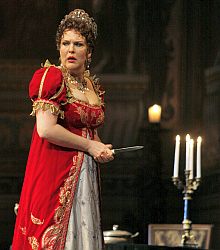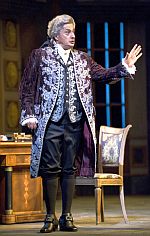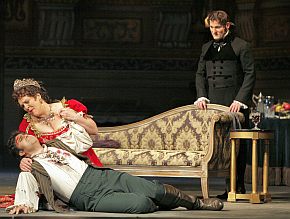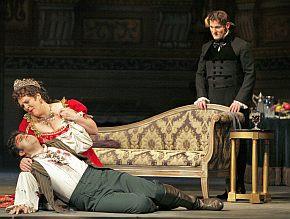
Photos by Cory Weaver
Thus the cast of the current summer-season opener, heard Tuesday night, bears great expectations. With one exception, however, this is a much meeker group than those named above.
Foremost in an unexpected role interpretation is Adrianne Pieczonka in her local debut. An imposing figure onstage, Pieczonka is tall and statuesque, with a full, pliant voice. But rather than being the haughty, jealous diva capable of being driven to murder for her lover, she went for a more vulnerable and easily led characterization. She was more often a pussycat eager to please than a tiger seething with revenge. Her well-sung rendition of the famous prayer “Vissi d’arte, vissi d’amore” (I have lived for art, I have lived for love) received her greatest audience response, and for this she seemed pleased. The recipient of many international awards, Pieczonka gathered attention recently as the substitute Sieglinde for the Metropolitan Opera revival of Wagner’s Ring of the Nibelung. Perhaps that character’s constant pleading kept the soprano from finding the grit of this Tosca.

Tenor Carlo Ventre made an impassioned Mario Cavaradossi, his voice well-suited to the verismo style. Yet his, too, was a gentler, more moderate interpretation. And while his two major arias (the paean to art, “Recondite armonia,” and the reflective “E lucevan le stelle”) earned him easy applause, much of their effect was undermined by his excessive rolling of his r’s. (In fact, one wag shouted out on opening night, mocking him.) He was especially convincing in his final duet with Tosca, “O dolce mani” (Hands so sweet and pure).
The power center of this performance, though, was the Baron Scarpia of bass Lado Ataneli, making his local debut. Here was all the arrogance, threat, and venality of the character that Puccini created. Ataneli’s voice is large, supple, and at times thrilling. Whenever he was onstage, he quickly took command and the drama came to life. From his opening condemnation of the uproar in church (“Un tal baccano in chiesa!”) to his confession of lust for Tosca (“Tosca, mi fai dimenticare Iddio!”), to his admission of venality (“Già mi dicon venal”), Ataneli teemed with menace. He also caught well the character’s subtle manners, moving like the elegant baron that he is, as well as the powerful Chief of Police.
Still, much of Scarpia’s motivation is only implied. In the backstory that takes place before the opera begins, Scarpia has been threatened by the Queen of Rome to find the political rebel Angelotti or face his own execution. Thus bass Jordan Bisch caught all of that escapee’s urgency, even in his brief appearance. Likewise, Joel Sorensen and Austin Kness abetted Scarpia’s desperation as his henchmen Spoletta and Sciarrone, while bass Dale Travis was the easily intimidated Sacristan. And Kenneth Kellog was an appropriately taciturn jailer.
Less-Than-Compelling Pacing
Marco Armiliato is a conductor well-known for his Italianate passion, and though he frequently captured Puccini’s theatrical drive and urgency, yet so did his pacing often fall slack. The great climax of Act 1 with its ever-escalating sounds (the chanted Latin Mass in Rome’s second most powerful church, the
Adrianne Pieczonka as Tosca
and Joel Sorensen as Spoletto
Thierry Bosquet’s settings are massive and atmospheric, a re-creation of the 1932 designs for the opening of the War Memorial Opera House. Alas, stage director Jose Maria Condemi did not fill them well. Scarpia’s forbidding apartment in the Farnese Palace seemed void of power and caused the singers to run to confront one another. There was also an excess of familial clutching by Scarpia and Tosca, something these powerful personalities would never have allowed, and their sexual grappling was clumsily directed and almost risible. Tosca’s desperate suicidal leap was hardly the climaxing thrill that it should have been.
While Puccini’s theatrical achievement in Tosca has been demeaned by some (the labeling as “A shabby little shocker” by one UC professor being an unfortunate example), the opera does pose some interesting questions. For instance, to what degree is power maintained by perception? (Puccini’s answer lies in Scarpia’s grandiose music.) Or does arrogant authority often cover arrogant corruption (listen to Scarpia’s “Mi dicon venal”)? And is the diversity of life not in itself a kind of art (consider Cavaradossi’s “Recondite armonia”)? In sum, it is Puccini’s masterful score, when well-performed, that makes this opera so compelling. This, though, was a tepid Tosca.

